Fort Knox: America’s Gold Vault
13/06/2024Daniel Fisher
Free & fully insured UK Delivery. Learn more
Secure & flexible payments. Learn more

Buyback Guarantee Learn more
Fort Knox is one of the most secure and mysterious places in the world, sparking intrigue and fascination for decades. Nestled in the heart of Kentucky, this iconic fortress is not only synonymous with gold, but also with unparalleled security. The term “As secure as Fort Knox” has become well-used to describe anything that is deemed safe and secure.
For many, Fort Knox evokes images of towering walls, mysterious vaults, and layers of security measures that make it nearly impenetrable. Beyond its physical presence, Fort Knox holds a wealth of history and financial significance that extends far beyond its fortified gates.
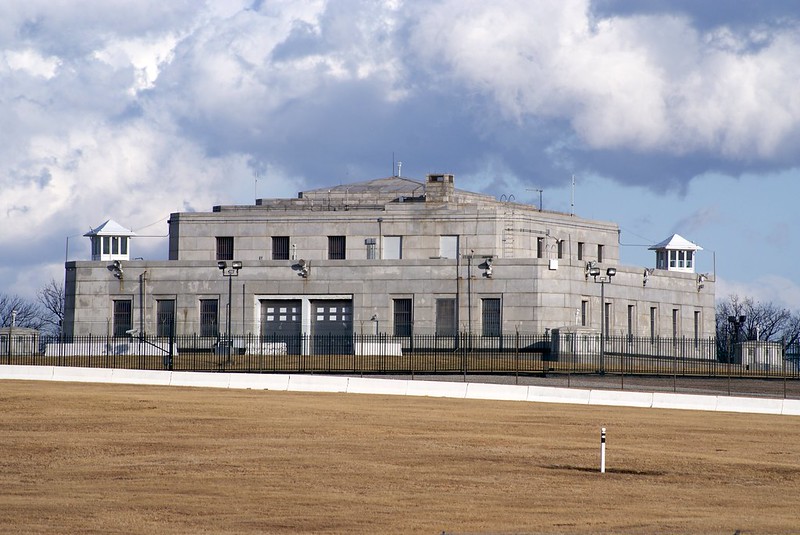
Fort Knox, officially known as the United States Bullion Depository, is one of the most secure and well-known facilities in the world. It serves as a symbol of the United States’ economic strength and security, housing a significant portion of the nation’s gold reserves. But what exactly is Fort Knox, and why does it hold such a prominent place in American history and culture? Let’s delve into its location, history, and primary functions to understand its importance.
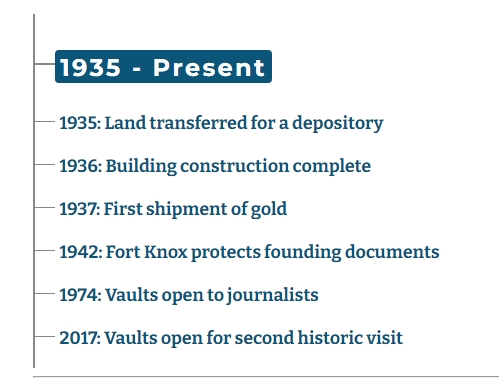
Fort Knox is located in the state of Kentucky, approximately 30 miles southwest of Louisville. The facility is situated on a military base, Fort Knox Military Reservation, which spans parts of Hardin, Meade, and Bullitt counties. The area was selected for its strategic location and the natural protection provided by the surrounding terrain.
The history of Fort Knox dates back to the 1930s, during the Great Depression. It was constructed in 1936, in response to President Franklin D. Roosevelt’s Executive Order 6102, which required Americans to exchange their gold for paper currency. This led to the need for a secure place to store the nation’s gold reserves. The facility was completed in December 1936, and the first shipment of gold arrived in January 1937, incredibly by US mail.
Since its establishment, Fort Knox has played a crucial role in the nation’s financial security. During World War II, it also served as a repository for important documents and artifacts, including the Magna Carta and the Declaration of Independence, to protect them from potential threats.
The primary purpose of Fort Knox is to serve as a secure storage facility for the United States’ gold reserves. It is managed by the United States Department of the Treasury and the United States Mint. The depository holds a significant portion of the nation’s gold, although the exact amount is a closely guarded secret. Estimates suggest that it contains approximately 147.3 million ounces of gold, which represents a substantial portion of the US government’s reserves.
In addition to storing gold, Fort Knox has served other functions over the years. During times of national crisis, it has been used to safeguard important documents and treasures. For example, during World War II, it housed the original copies of the US Constitution and the Declaration of Independence.
Fort Knox also plays a role in the broader context of the United States’ financial system. The gold stored at the depository is part of the nation’s monetary reserve, providing a foundation for economic stability and confidence. While the gold standard is no longer used as a basis for currency, the presence of such a significant gold reserve contributes to the perceived strength and security of the US economy.
Browse prices on gold bars ranging from 5 grams up to 1 Kilo
Fort Knox’s gold vault is renowned for its impenetrable security and robust construction, making it one of the most secure places on Earth. This section explores the intricate details of the vault’s construction and design, as well as the formidable security measures that protect the nation’s gold reserves.
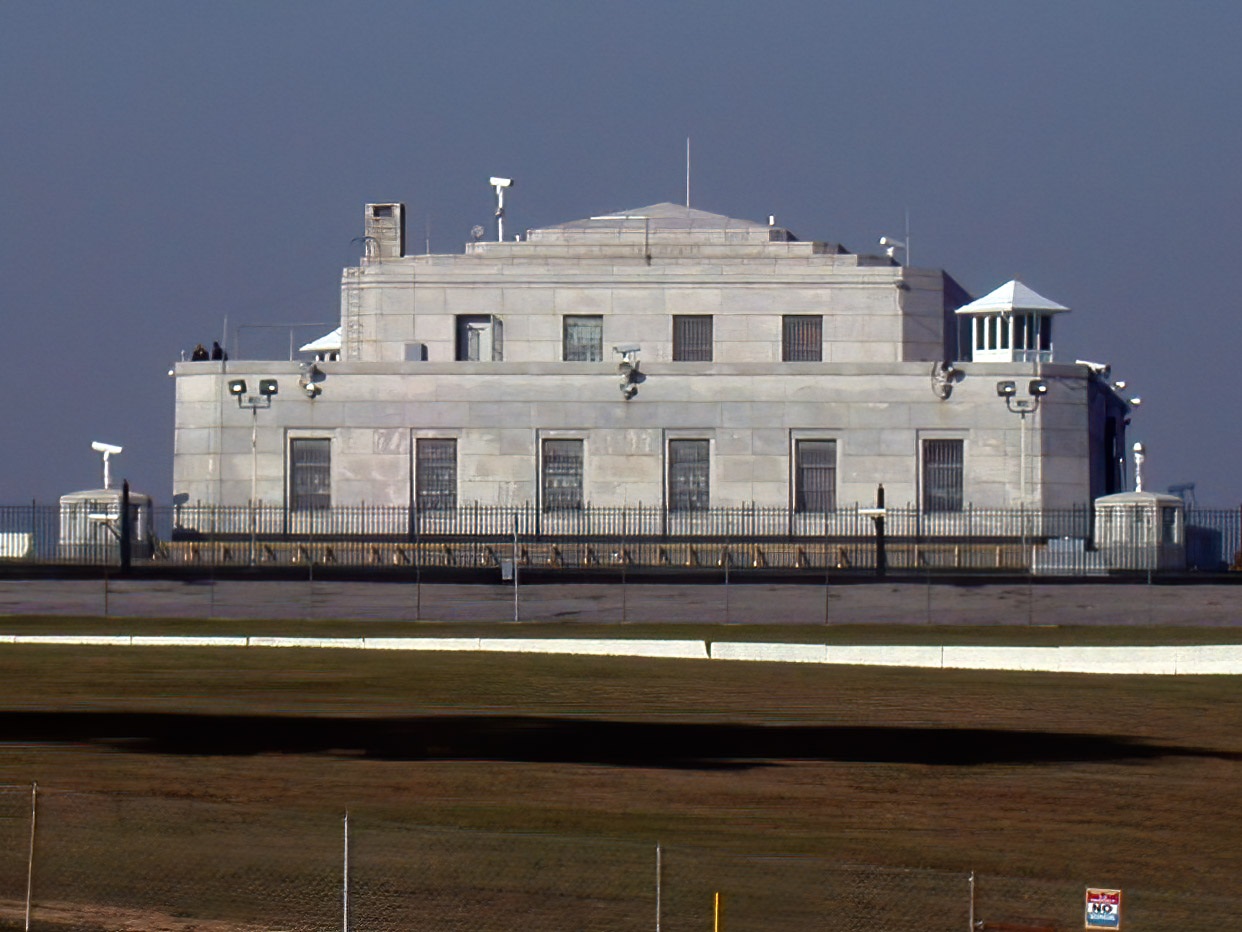
The construction of the Fort Knox gold vault was a monumental engineering feat, undertaken in the mid-1930s during the Great Depression. The severity and impact of the economic depression influenced Fort Knox’s creation and design in two ways. The tumbling value of the US Dollar inspired the decree to confiscate and subsequently store gold at a large facility.
The public’s desperation and poverty meant that theft of assets was a significant threat, consequently requiring the vault’s construction and security to be unsurpassed. Completed in December 1936, the facility was designed to be both highly secure and virtually indestructible.
The main vault building is a rectangular structure made of granite, steel, and reinforced concrete. The outer walls are made of granite, while the interior walls consist of a concrete-lined steel framework. This combination of materials provides immense strength and durability, ensuring the vault can withstand various forms of attack.
The roof is similarly fortified, comprising a concrete and steel composition capable of resisting aerial assaults. The building also features a basement and a sub-basement, which add additional layers of protection.
One of the most notable features of the vault is its massive door, which weighs an astonishing 22 tons. This door is made of steel and concrete, and it is secured with a complex lock system that requires multiple combinations to open. Only a select group of personnel, each with knowledge of only part of the combination, can unlock the door, ensuring that no single individual can gain access to the vault alone.
In combination with the solid structure, careful security measures further protect the facility’s integrity. Whenever humans are involved, there is the possibility of infiltration, so strict rules and regulations apply. These measures encompass a range of physical and technological defences designed to deter and respond to any potential threats.
Two very basic measures lay the foundation to protect the gold held within. Facility knowledge is heavily restricted, with very few people knowing full details of the building and its content. No single person is privy to the full set of procedures to open the vault itself.
Secondly, movements are kept to a bare minimum, with only tiny amounts of gold ever removed for scheduled purity testing to meet audit requirements.
The first layer of physical security is the perimeter fencing, which surrounds the entire facility. This fencing is patrolled by armed guards from the United States Mint Police, who maintain a constant presence to deter unauthorized access.
In addition to the physical barriers, Fort Knox employs advanced surveillance systems, including high-resolution cameras and motion detectors, to monitor the facility around the clock. These systems are integrated with a central control room, where security personnel can quickly respond to any suspicious activity.
The vault itself is protected by a multi-layered security system that includes electronic alarm systems, biometric verification, and armed guards. The interior of the vault is divided into several compartments, each secured with its own set of locks and alarms. This compartmentalization ensures that even if one section is breached, the rest of the vault remains secure.
Furthermore, the facility’s location on a military base adds an additional layer of protection. Fort Knox is home to the United States Army’s Human Resources Command and various other military units, ensuring a rapid and coordinated response in the event of an emergency.
Free ultimate guide for keen precious metals investor
Fort Knox is famously known for its immense stockpile of gold, serving as a key element in the financial security of the United States. But how much gold exactly is stored within the vault and what are the main reasons behind its storage there?

The precise amount of gold stored at Fort Knox is a closely guarded secret, but it is estimated to hold approximately 147.3 million ounces of gold. This makes it one of the largest repositories of gold in the world, holding around 15 times the total UK gold reserves. This doesn’t represent the entirety of the US’s 248 million ounces gold reserves, but it is by far the largest constituent. Other major facilities are based in Denver and West Point.
Each gold bar stored at Fort Knox weighs roughly 400 troy ounces (about 27.5 pounds or 12.4 kilograms). These bars are of standard size and are typically around 7 inches long, 3.5 inches wide, and 1.75 inches thick. The purity of the gold bars is approximately 99.8%.
The book value of the gold held at Fort Knox is set by the U.S. Department of the Treasury and is currently fixed at $42.22 per troy ounce. However, this price is not reflective of the current market value of gold bars, which can fluctuate significantly. Recent market conditions have propelled the market value per ounce of gold considerably higher, easily exceeding $2,000 per troy ounce.
Historically, the peak amount of gold held at Fort Knox was in 1941, during World War II, when it contained nearly 649.6 million ounces. This period marked the height of gold accumulation, largely due to increased wartime reserves and economic measures.
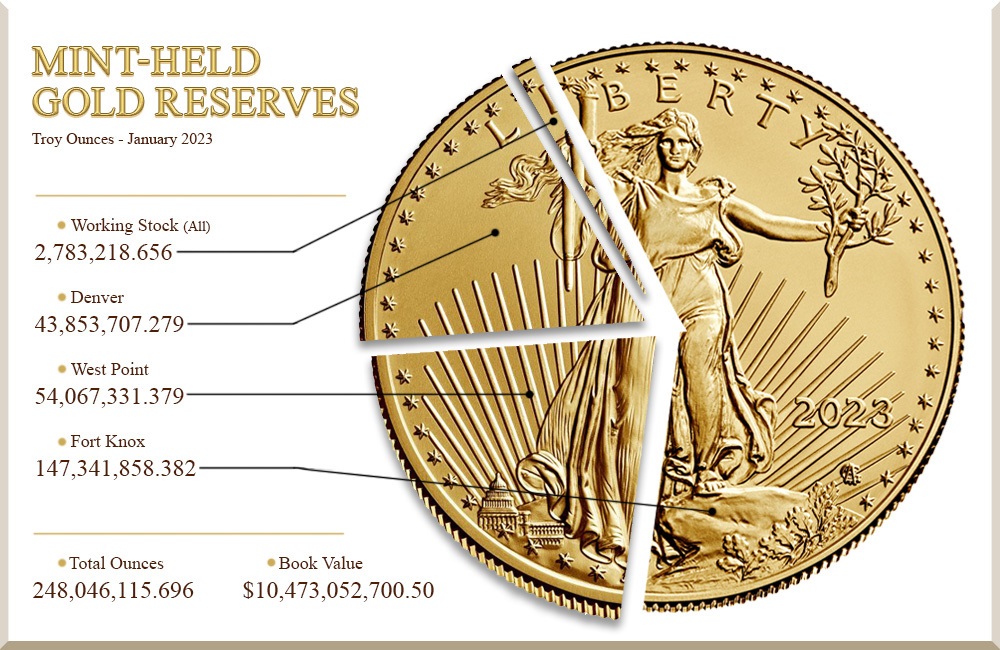
The proportion of US Gold Reserves held at Fort Knox. Image from https://www.usmint.gov/about/mint-tours-facilities/fort-knox
The decision to store gold at Fort Knox stems from several historical, economic, and strategic reasons. It grew out of an era of World Wars, socio-political unrest, and economic hardship. With the US needing to secure its reserves and cement its global position, the need for a new facility grew.
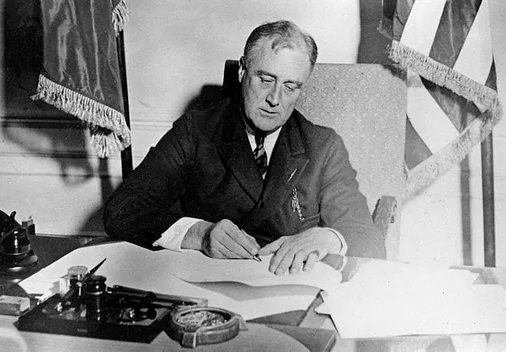
The establishment of Fort Knox as a gold depository was a direct response to President Franklin D. Roosevelt’s Executive Order 6102 in 1933, which required Americans to exchange their gold coins, gold bullion, and gold certificates for paper currency. This was part of the government’s effort to combat the Great Depression and stabilize the economy.
The need for a secure location to store the nation’s gold reserves led to the construction of the Fort Knox facility. Locating the facility 1,000 miles inland from the East coast was deemed necessary with the growing threat from Hitler in the 1930s. Previously, a majority of the US gold reserves were stored in New York and Philadelphia, which were more vulnerable to attack from Europe.
Gold has historically been seen as a safe and stable store of value, especially during times of economic uncertainty. Although the United States abandoned the gold standard in 1971, the gold reserves at Fort Knox continue to play a symbolic role in demonstrating the economic strength and stability of the nation. The presence of such a significant gold reserve underpins confidence in the country’s financial system and helps to stabilize the economy in times of crisis.
The location of Fort Knox was chosen for its strategic advantages, including its remote location and the natural protection offered by the surrounding terrain. Additionally, being situated on a military base provides an extra layer of security, with the presence of the United States Army ensuring rapid response capabilities in case of any threats.
Our automated portfolio builder will provide suggestions based on various investment objectives
Fort Knox’s reputation as one of the world’s most secure facilities has naturally led to a wealth of stories and rumours. From daring heist plots to hidden treasures, the mystique of Fort Knox continues to captivate the public’s imagination.
All the Gold is Gone
One of the most persistent myths about Fort Knox is that it no longer holds any gold. Conspiracy theorists have long claimed that the gold reserves were secretly removed or never existed in the quantities reported. Despite numerous audits and reassurances from the U.S. government, this myth continues to thrive, fuelled by a lack of public tours and limited access to the vault.
There Are Hidden Treasures
Another common legend is that Fort Knox houses more than just gold. Some believe that it also contains priceless historical artifacts, secret government documents, or even alien technology. These theories often reference the fact that during World War II, Fort Knox temporarily stored valuable documents like the Magna Carta and the U.S. Constitution, adding an element of truth to the otherwise fantastical claims.
The Vault Can Withstand Anything
While Fort Knox is undoubtedly one of the most secure locations in the world, some myths exaggerate its indestructibility. Stories suggest that the vault is impervious to nuclear attacks, natural disasters, and even science fiction-style invasions. While the facility is exceptionally well-protected, these claims often stretch the limits of reality.
Fort Knox in Movies and TV Shows
Fort Knox has been a popular setting in numerous films and television shows, often depicted as the ultimate challenge for thieves and spies. One of the most famous portrayals is in the James Bond film “Goldfinger” (1964), where the titular villain plots to detonate a nuclear bomb inside the vault to contaminate the U.S. gold supply. This portrayal has cemented Fort Knox’s image as an impenetrable fortress in popular culture.
Another notable example is the movie “Die Hard with a Vengeance” (1995), where the villain’s plan involves stealing the gold from the Federal Reserve Bank of New York, with references to the security measures akin to those of Fort Knox.
Literature and Video Games Depicting Fort Knox
Fort Knox also appears in various books and video games, further embedding its legendary status. In literature, thrillers and heist novels often feature Fort Knox as the ultimate target for daring protagonists. Video games, such as the “Call of Duty” series, sometimes include missions set in or around Fort Knox, emphasizing its secure and strategic importance.
Even in music and art, Fort Knox’s imagery is used to symbolize unbreakable security and immense wealth. Songs and artwork referencing Fort Knox often evoke themes of invincibility and ultimate protection.
Fort Knox, with its legendary status and high-security measures, naturally stimulates the interest and imagination of many who wonder if they can catch a glimpse of its inner workings. But is the facility accessible to the public and which methods are best to uncover more details about this iconic location?
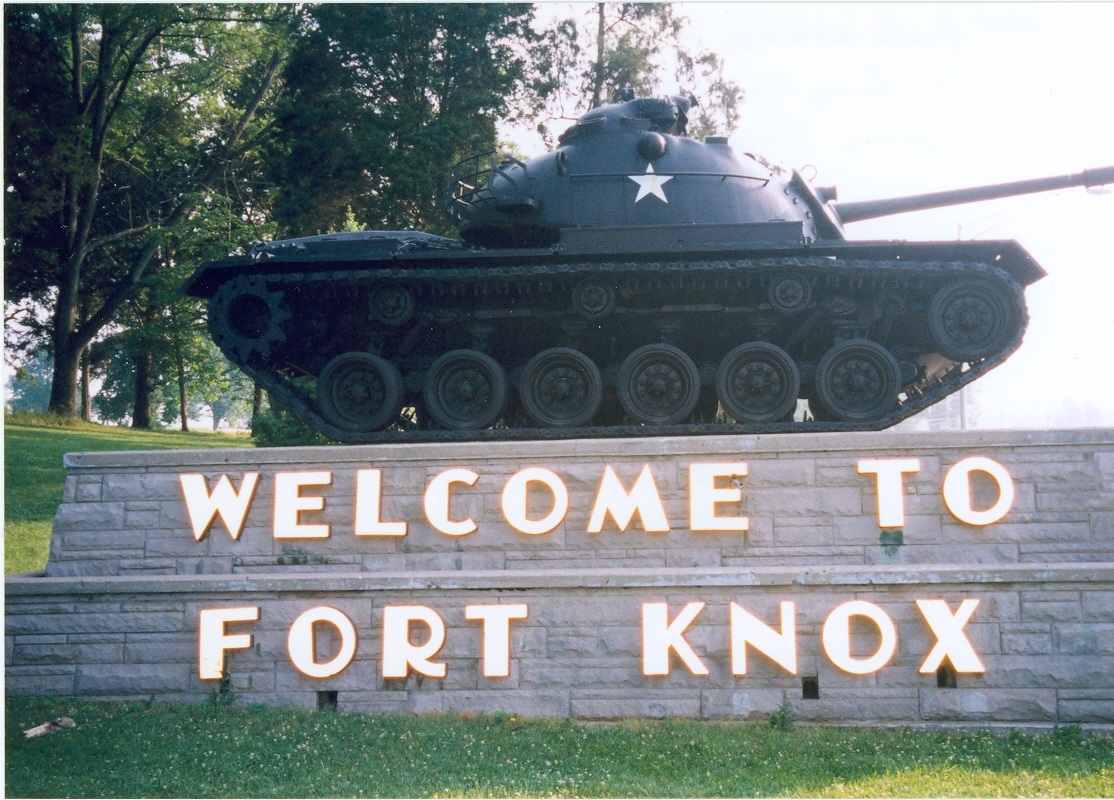
Unfortunately, Fort Knox is not open to the public. The United States Bullion Depository, where the gold is stored, is a highly secure facility with restricted access. Only authorized personnel, including Treasury and Mint officials, are allowed entry. This stringent security is essential to maintain the integrity and safety of the gold reserves. This simple rule is no different to the Bank of England’s gold vaults, or those of commercial depositories such as Loomis or Brinks.
Occasionally, high-ranking government officials and members of Congress may be granted limited access for official inspections or special tours. These visits are rare and closely monitored to ensure the utmost security.
Although you cannot visit the depository itself, there are other ways to explore the history and significance of Fort Knox:
General George Patton Museum of Leadership
Located on the Fort Knox military base, the General George Patton Museum of Leadership offers a fascinating glimpse into military history. While it does not provide access to the gold vault, the museum features exhibits on leadership, military artifacts, and the history of Fort Knox as an Army training ground. The museum is open to the public, and visitors can learn about the broader historical context of the area.
Virtual Tours and Online Resources
For those who want to delve deeper into the mysteries of Fort Knox from the comfort of their home, various virtual tours and online resources are available. Websites dedicated to the history of Fort Knox and the U.S. Treasury provide detailed information, photographs, and even virtual tours of the facility’s exterior and surrounding areas. These resources offer valuable insights into the architecture, security measures, and historical significance of Fort Knox.
Books and Documentaries
Numerous books and documentaries cover the history and intrigue of Fort Knox. These works often include interviews with former officials, historians, and security experts, providing a comprehensive look at the depository’s operations and the myths that surround it. Reading books or watching documentaries can be an enriching way to learn more about Fort Knox’s role in American history.


As one of the most iconic and secure facilities in the world, Fort Knox’s future is a topic of considerable interest and speculation. As technology advances, so does the threat to Fort Knox’s security and existence. Defence measures need to constantly evolve to keep ahead of possible attacks. Digital currencies and a globalized economy can also shift the needs for keeping large quantities of gold in reserve.
Technological Advancements
Fort Knox continually evolves to incorporate the latest technological advancements in security and surveillance. Future upgrades are likely to focus on enhancing these technologies to ensure that the facility remains impenetrable. Innovations such as advanced biometric systems, AI-driven surveillance, and state-of-the-art intrusion detection systems will likely be integrated to bolster the existing security infrastructure.
Structural Enhancements
Maintaining the physical integrity of Fort Knox is paramount. Growing global geo-political unrest increases the possibility of terrorist and rogue state attacks. Periodic structural assessments are conducted to ensure the facility can withstand potential threats, both natural and man-made. Future enhancements may include reinforced barriers, upgraded vault doors, and improved perimeter defences to further fortify the depository.
Environmental and Energy Efficiency
As part of broader efforts to promote sustainability, Fort Knox may also see upgrades aimed at improving environmental and energy efficiency. Implementing green technologies, such as solar power, energy-efficient lighting, and advanced climate control systems, could help reduce the facility’s environmental footprint while maintaining its operational integrity.
Economic Significance
While the gold standard is no longer used, the gold stored at Fort Knox continues to play a symbolic role in the economic stability of the United States. The presence of a substantial gold reserve underpins confidence in the nation’s financial system, especially as inflation spikes and the Dollar depreciates. As global economic conditions fluctuate, maintaining a robust gold reserve at Fort Knox helps ensure that the United States retains a strong financial foundation.
This is particularly relevant as new superpowers such as China threaten the dominance of the US Dollar as the world’s reserve currency. Blockchain technology is increasingly being adopted for various real-world uses, not least the talk of Central Bank Digital Currencies (CBDC). With all the major nations or regions planning to launch their own CBDC, it will be interesting to monitor the role of the gold reserves kept at Fort Knox.
Strategic Importance
Fort Knox’s strategic importance extends beyond its role as a gold depository. The facility is part of a larger military base that houses various Army units and commands. This dual-purpose function enhances its relevance as both a financial and strategic asset. The military presence ensures that Fort Knox can respond rapidly to any threats, maintaining its status as a critical national security asset.
Historical and Cultural Legacy
Fort Knox’s historical and cultural legacy continues to captivate the public imagination. As a symbol of security and wealth, it remains an integral part of American heritage. Efforts to preserve and celebrate this legacy, through educational programs, historical documentation, and public engagement, will help ensure that Fort Knox retains its iconic status for future generations.
Fort Knox is famous for housing the United States Bullion Depository, one of the world’s most secure vaults containing a significant portion of the nation’s gold reserves. Its reputation for impenetrable security, along with its role in American financial and military history, contributes to its iconic status.
Fort Knox is currently used for housing the United States Bullion Depository, which stores a large portion of the nation’s gold reserves. Additionally, it serves as a major military installation, home to the Army’s Human Resources Command and various training and support units.
Yes, Fort Knox is still heavily guarded. It features extensive security measures including armed guards, advanced surveillance systems, and physical barriers. The United States Mint Police and military personnel provide constant protection, ensuring the safety of the gold reserves stored within the facility.
Only a few individuals outside the U.S. Treasury Department have been inside Fort Knox’s gold vault. Notable visits include President Franklin Roosevelt and a 1974 inspection by journalists and Congress members. Access remains highly restricted to ensure security.
Images: Flickr, Wikimedia Commons, Wikimedia Commons, US Mint
Live Gold Spot Price in Sterling. Gold is one of the densest of all metals. It is a good conductor of heat and electricity. It is also soft and the most malleable and ductile of the elements; an ounce (31.1 grams; gold is weighed in troy ounces) can be beaten out to 187 square feet (about 17 square metres) in extremely thin sheets called gold leaf.
Live Silver Spot Price in Sterling. Silver (Ag), chemical element, a white lustrous metal valued for its decorative beauty and electrical conductivity. Silver is located in Group 11 (Ib) and Period 5 of the periodic table, between copper (Period 4) and gold (Period 6), and its physical and chemical properties are intermediate between those two metals.